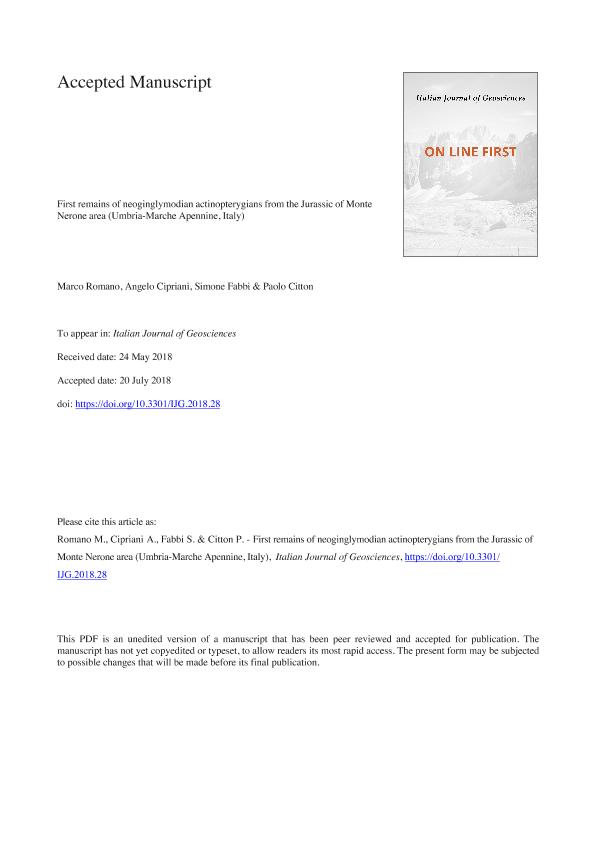Mostrar el registro sencillo del ítem
dc.contributor.author
Romano, Marco

dc.contributor.author
Cipriani, Angelo

dc.contributor.author
Fabbi, Simone

dc.contributor.author
Citton, Paolo

dc.date.available
2021-02-17T16:20:28Z
dc.date.issued
2019-02
dc.identifier.citation
Romano, Marco; Cipriani, Angelo; Fabbi, Simone; Citton, Paolo; First remains of neoginglymodian actinopterygians from the Jurassic of Monte Nerone area (Umbria-Marche Apennine, Italy); Società Geologica Italiana; Italian Journal of Geosciences; 138; 1; 2-2019; 88-102
dc.identifier.issn
2038-1719
dc.identifier.uri
http://hdl.handle.net/11336/125811
dc.description.abstract
Since the early nineteenth century, the structural high of Mt. Nerone in the Umbria-Marche-Sabina Domain (UMS - Central/ Northern Apennines, Italy) attracted scholars from all over Europe due to the wealth of fossil fauna preserved in a well-exposed Mesozoic sedimentary succession. Several geo-palaeontological studies were focused on the abundant and diverse invertebrate fauna, whereas contributions dealing with Mesozoic vertebrates were to date virtually lacking. Recently, the first material referable to hybodont sharks, consisting of an articulated crushing dentition, was described from the area and referred to Asteracanthus cf. A. magnus. In this contribution, we report the first evidence of ginglymodian actinopterygians from the Upper Jurassic of Mt. Nerone. The material is represented by seven highly tritorial isolated teeth collected from three classic fossiliferous localities of the area (i.e. Pian del Sasso, Fosso Pisciarello, I Ranchi). The general morphology of the material under study allow us to conservatively refer the teeth to the Neoginglymodi, a clade formed by Lepisosteiformes and Semionotiformes. The occurrence of durophagous organisms, to date represented by hybodont sharks and ginglymodian fishes, reveals interesting palaeoecological scenarios characterizing the pelagic carbonate platform-basin system of Mt. Nerone, which were most likely triggered by large-scale geodynamic processes. The complex submarine palaeotopography, inheritance of the Western Tethys Early Jurassic rifting, aroused the establishment of new infaunal and epifaunal communities opening up unexplored trophic niches for durophagous predators. The particular geodynamic setting of the UMS Domain, consisting of predominantly interconnected structural highs and lows, and the relative evolution of a diverse invertebrate fauna characterized by terebratulid, ostreids, limids, brachiopods, crustaceans, and gastropods, attracted both hybodontids and durophagous ginglymodians in the Tethyan realm, influencing their dispersal during the Late Jurassic.
dc.format
application/pdf
dc.language.iso
eng
dc.publisher
Società Geologica Italiana
dc.rights
info:eu-repo/semantics/openAccess
dc.rights.uri
https://creativecommons.org/licenses/by-nc-sa/2.5/ar/
dc.subject
GINGLYMODIAN ACTINOPTERYGIANS
dc.subject
LATE JURASSIC
dc.subject
LEPIDOTES
dc.subject
PALAEOECOLOGY
dc.subject
PELAGIC CARBONATE PLATFORM
dc.subject.classification
Paleontología

dc.subject.classification
Ciencias de la Tierra y relacionadas con el Medio Ambiente

dc.subject.classification
CIENCIAS NATURALES Y EXACTAS

dc.subject.classification
Geología

dc.subject.classification
Ciencias de la Tierra y relacionadas con el Medio Ambiente

dc.subject.classification
CIENCIAS NATURALES Y EXACTAS

dc.title
First remains of neoginglymodian actinopterygians from the Jurassic of Monte Nerone area (Umbria-Marche Apennine, Italy)
dc.type
info:eu-repo/semantics/article
dc.type
info:ar-repo/semantics/artículo
dc.type
info:eu-repo/semantics/publishedVersion
dc.date.updated
2020-11-19T21:38:27Z
dc.identifier.eissn
2038-1727
dc.journal.volume
138
dc.journal.number
1
dc.journal.pagination
88-102
dc.journal.pais
Italia

dc.journal.ciudad
Roma
dc.description.fil
Fil: Romano, Marco. University of the Witwatersrand; Sudáfrica. Università degli Studi di Roma "La Sapienza"; Italia. Apennine Team; Italia
dc.description.fil
Fil: Cipriani, Angelo. Università degli Studi di Roma "La Sapienza"; Italia. Apennine Team; Italia
dc.description.fil
Fil: Fabbi, Simone. Università degli Studi di Roma "La Sapienza"; Italia. Apennine Team; Italia. Consiglio Nazionale delle Ricerche; Italia
dc.description.fil
Fil: Citton, Paolo. Consejo Nacional de Investigaciones Científicas y Técnicas. Centro Científico Tecnológico Conicet - Patagonia Norte. Instituto de Investigación en Paleobiología y Geología; Argentina. Universidad Nacional de Río Negro. Sede Alto Valle. Instituto de Investigaciones en Paleobiología y Geología; Argentina. Università degli Studi di Roma "La Sapienza"; Italia. Apennine Team; Italia. Consiglio Nazionale delle Ricerche; Italia
dc.journal.title
Italian Journal of Geosciences
dc.relation.alternativeid
info:eu-repo/semantics/altIdentifier/doi/http://dx.doi.org/10.3301/IJG.2018.28
dc.relation.alternativeid
info:eu-repo/semantics/altIdentifier/url/https://www.italianjournalofgeosciences.it/297/article-964/first-remains-of-neoginglymodian-actinopterygians-from-the-jurassic-of-monte-nerone-area-umbria-marche-apennine-italy.html
Archivos asociados
